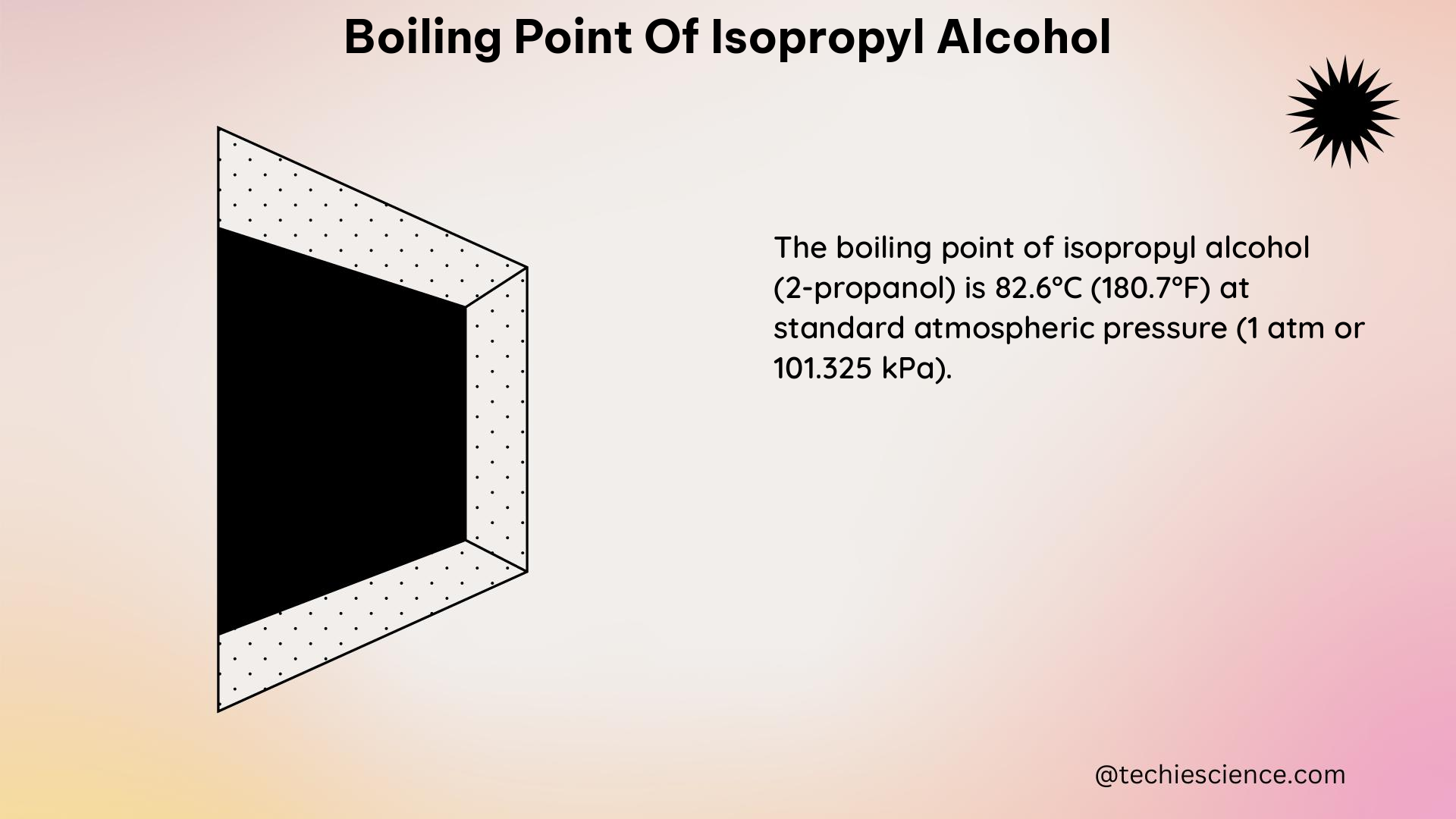The boiling point of isopropyl alcohol, also known as 2-propanol or rubbing alcohol, is a crucial property that has been extensively studied and documented. This compound, with the chemical formula (CH3)2CHOH, is widely used in various industries, from healthcare to manufacturing, and understanding its boiling point is essential for many applications.
Understanding the Boiling Point of Isopropyl Alcohol
The boiling point of isopropyl alcohol is the temperature at which the vapor pressure of the liquid equals the pressure surrounding the liquid, and bubbles of vapor form inside the liquid. This temperature is a characteristic property of the substance and is influenced by factors such as molecular structure, intermolecular forces, and atmospheric pressure.
Molecular Structure and Intermolecular Forces
The boiling point of isopropyl alcohol is primarily determined by the strength of the intermolecular forces, specifically hydrogen bonding, between the molecules. The presence of the hydroxyl (-OH) group in the isopropyl alcohol molecule allows for the formation of hydrogen bonds, which increase the cohesive forces between the molecules and result in a higher boiling point compared to non-polar compounds of similar molecular weight.
Atmospheric Pressure and Boiling Point
The boiling point of isopropyl alcohol is also affected by the atmospheric pressure. According to the Clausius-Clapeyron equation, the boiling point of a liquid is inversely proportional to the logarithm of the surrounding pressure. This means that as the pressure decreases, the boiling point of isopropyl alcohol also decreases.
Experimental Determination of the Boiling Point

The boiling point of isopropyl alcohol has been measured through various experimental methods, including:
- Distillation: Isopropyl alcohol is heated, and the temperature at which the vapor condenses is recorded as the boiling point.
- Vapor Pressure Measurement: The vapor pressure of isopropyl alcohol is measured at different temperatures, and the boiling point is determined as the temperature at which the vapor pressure equals the surrounding pressure.
- Differential Scanning Calorimetry (DSC): This technique measures the heat flow associated with phase changes, such as the boiling point, as a function of temperature.
Reported Boiling Point Values
According to the information provided, the boiling point of isopropyl alcohol is 82.3°C (180.1°F) at a pressure of 760 mmHg (1 atm). This value is consistent across various sources, indicating a high level of agreement and accuracy in the measurements.
Other Quantifiable Properties of Isopropyl Alcohol
In addition to the boiling point, isopropyl alcohol has several other quantifiable properties that are important to consider:
- Molecular Weight: The molecular weight of isopropyl alcohol is 60.10 g/mol.
- Density: The density of isopropyl alcohol is 0.785 g/mL at 20°C.
- Freezing Point: The freezing point of isopropyl alcohol is -89.5°C (-129.1°F).
- Azeotrope with Water: Isopropyl alcohol forms an azeotrope with water, which is a mixture of two or more liquids that boil at a constant temperature. The boiling point of the isopropyl alcohol-water azeotrope is 80.37°C (176.67°F), and its composition is 87.7% by mass (91% by volume) isopropyl alcohol.
Factors Affecting the Boiling Point
The boiling point of isopropyl alcohol can be influenced by several factors, including:
- Purity: The presence of impurities in the isopropyl alcohol sample can affect its boiling point, as impurities can alter the intermolecular forces and vapor pressure.
- Atmospheric Pressure: As mentioned earlier, the boiling point of isopropyl alcohol is inversely proportional to the surrounding pressure. Changes in altitude or atmospheric conditions can affect the observed boiling point.
- Composition: The boiling point of isopropyl alcohol can be influenced by the composition of the sample, particularly if it is mixed with other substances, such as water.
Applications and Considerations
The boiling point of isopropyl alcohol is an important property that has numerous applications, including:
- Chemical Processes: The boiling point is crucial in processes such as distillation, evaporation, and condensation, where the phase changes of isopropyl alcohol are involved.
- Safety and Handling: The boiling point information is essential for the safe handling and storage of isopropyl alcohol, as it can help prevent accidents and ensure proper containment.
- Product Formulation: The boiling point data is used in the formulation of products containing isopropyl alcohol, such as cleaning solutions, disinfectants, and personal care products.
When working with isopropyl alcohol, it is essential to consider the boiling point and other quantifiable properties to ensure safe and effective use, as well as to optimize the performance of processes and products.
Conclusion
The boiling point of isopropyl alcohol is a well-established and quantifiable property that has been extensively studied and documented. The reported boiling point of 82.3°C (180.1°F) at 760 mmHg is consistent across various sources, indicating a high level of agreement and accuracy in the measurements. Understanding the factors that influence the boiling point, such as molecular structure, intermolecular forces, and atmospheric pressure, is crucial for many applications involving isopropyl alcohol. By considering the boiling point and other quantifiable properties of this compound, scientists, engineers, and industry professionals can ensure safe and effective use, as well as optimize the performance of processes and products.
References:
– Info. (n.d.). Isopropyl alcohol / Boiling point: 180.1°F (82.3°C). Retrieved from https://www.info.com/isopropyl-alcohol/boiling-point
– Wikipedia. (2023, June 17). Isopropyl alcohol. Retrieved from https://en.wikipedia.org/wiki/Isopropyl_alcohol
– PubChem. (n.d.). Isopropyl Alcohol | (CH3)2CHOH | CID 3776. Retrieved from https://pubchem.ncbi.nlm.nih.gov/compound/Isopropyl-Alcohol
– Digital Commons. (n.d.). Vapor-liquid equilibria, binary mixtures of methyl alcohol, isopropyl … Retrieved from https://digitalcommons.njit.edu/cgi/viewcontent.cgi?article=3220&context=theses
– Homework.Study.com. (n.d.). What is the boiling point of rubbing alcohol? Retrieved from https://homework.study.com/explanation/what-is-the-boiling-point-of-rubbing-alcohol.html
– INCHEM. (n.d.). Isopropyl alcohol (PIM 290). Retrieved from https://inchem.org/documents/pims/chemical/pim290.htm

The lambdageeks.com Core SME Team is a group of experienced subject matter experts from diverse scientific and technical fields including Physics, Chemistry, Technology,Electronics & Electrical Engineering, Automotive, Mechanical Engineering. Our team collaborates to create high-quality, well-researched articles on a wide range of science and technology topics for the lambdageeks.com website.
All Our Senior SME are having more than 7 Years of experience in the respective fields . They are either Working Industry Professionals or assocaited With different Universities. Refer Our Authors Page to get to know About our Core SMEs.